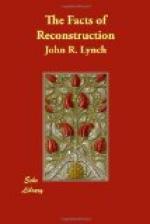CHAPTER XXVI
MISSISSIPPI AND THE NULLIFICATION OF THE FIFTEENTH AMENDMENT
The defeat or abandonment of the Lodge Federal Elections Bill was equivalent to a declaration that no further attempts would be made for a good while, at least, to enforce by appropriate legislation the war amendments to the Constitution. Southern Democrats were not slow in taking advantage of the knowledge of that fact.
My own State, Mississippi, was the first to give legal effect to the practical nullification of the Fifteenth Amendment. On that question the Democratic party in the State was divided into two factions. The radical faction, under the leadership of Senator George, advocated the adoption and enforcement of extreme methods. The liberal or conservative faction,—or what was known as the Lamar wing of the party under the leadership of Senator Walthall,—was strongly opposed to such methods. Senator George advocated the calling of a Constitutional Convention, to frame a new Constitution for the State. Senator Walthall opposed it, contending that the then Constitution, though framed by Republicans, was, in the main, unobjectionable and should be allowed to stand. But Senator George was successful, and a convention was called to meet in the fall of 1890. In order to take no chances the Senator had himself nominated and elected a member of the Convention.
When the Convention met, it was found that there were two strong factions, one in favor of giving legal effect to the nullification of the Fifteenth Amendment, and the other opposed to it. The George faction was slightly in the majority, resulting in one of their number,—nullificationists, as they were called,—Judge S.S. Calhoun, being elected President of the Convention. The plan advocated and supported by the George faction, of which Senator George was the author, provided that no one be allowed to register as a voter, or vote if registered, unless he could read and write, or unless he could understand any section of the Constitution when read to him and give a reasonable interpretation thereof. This was known as the “understanding clause.” It was plain to every one that its purpose was to evade the Fifteenth Amendment, and disfranchise the illiterate voters of one race without disfranchising those of the other.




